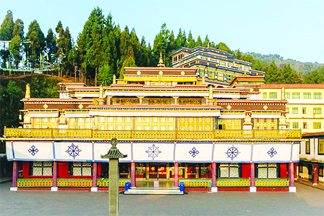
Sikkim is the second smallest state in India, and is wedged between Tibet, Nepal, Bhutan, and West Bengal, but encompasses an astounding range of pristine natural beauty of the Himalayas. A traveller’s guide to Sikkim explores the stunning beauty of this Himalayas hill town. The Sikkimese call their land ‘Ney Mayal Lyang’ that translates to ‘heaven.’
Sikkim is located in the north eastern part of India, but is not a part of the Seven Sister states. The state is famous for dazzling waterfalls, virgin forests, Tibetan style Buddhist Gompas, alpine meadows, rhododendron flowers and more. Kanchenjunga (also Kanchendzonga) at 8598 m is the third highest peak in the world, and lies in Sikkim.
More than 60 percent of the former Himalayan Kingdom of Sikkim is mountainous, and there are sizeable numbers of 6000 m peaks on the eastern and western borders of the state. Sikkim has an impressive literacy rate of more than 70 percent. It was merged with India in 1975, and is a prosperous state today.
Weather in most parts of Sikkim is pleasant throughout the year (except in higher altitudes), and that makes it a favourite of holidaymakers from the Indian plains in the summer months. Bengalis throng the tourist towns of Sikkim during their holiday season of Durga Puja in October-November. The state abounds in a variety of flora and fauna, and lucky ones may also sight the endangered red panda.
PELLING
Pelling lies in West Sikkim, perched at an altitude of 2100 m and is approximately 120 km away from Gangtok. At first glance Pelling looks like a cluster of concrete hotels, but there are unparalleled views of the snowy peaks. Sunrise over the Kanchenjunga is Pelling’s biggest charm. With plenty of budget accommodation options, it also makes for a great base to explore other parts of West Sikkim.
Chief sights in and around Pelling are Pemangyatse Monastery, built more than 300 years ago, which is beautifully located amid green gardens; a huge Buddha statue and statues of reincarnations of Padmasambhava; and Pemangyatse Monastery, famous for the Chaam dances (masked dances) held in February/March.
YUKSOM
The historic little town of Yuksom was the first capital of Sikkim when three Lamas converged from different directions and crowned the first Chogyal (King) in 1641. There is still a stone throne that marks the coronation spot, and is known as Norbugang Chorten, the site is called Norbugang Park. Yuksom has the charming feel of a hamlet; it is lower in altitude than Pelling and is situated in a valley. If you are coming to Yuksom (Also Yuksam) from Pelling, then a short detour will bring you to Rimbi Waterfalls which is quite a sight in the monsoon. Just 9 km before Yuksom, you will cross the Kanchenjunga Waterfall, which is a majestic waterfall falling from a great height.
There is a small pond known by the name of Kathok Lake in Yuksom, a short walk will bring you to a ridge where once stood a palace of the King of Sikkim. There are also two new colourful Gompas above Yuksom, but the most beautiful monastery is the 1701 built Dubdi Monastery. The path to Dubdi Monastery is lined with prayer flags and is located amid lush greenery.
TASHIDING
If coming from Yuksom, you will come across one of Sikkim’s prettiest falls. The Phamrong waterfalls are around halfway on the Yuksom-Tashiding route. Tashiding is a small town located high above the confluence of the Rangeet and Rathong rivers. Tashiding Gompa is the most sacred monastery in Sikkim, the mere sight of Thongwa Rangdol Chorten – a chorten inside the complex, is said to cleanse every one of their sins. The monastery is said to have been built in 1641 and is set in an idyllic location surrounded by many ancient looking white chortens. Tall prayer flags in white (called Darchor) line up the staircase path to Tashiding Monastery, while the views from the Gompa are superb. Intricately carved mani stones with the Buddhist mantra, Om Mani Padme Hum are piled up on one another to form a mani wall near the monastery complex.
RUMTEK MONASTERY
Undoubtedly, this is Sikkim’s most famous monastery, and every visitor to Sikkim is likely to visit the Rumtek Monastery, even in a 3-4 day trip to Sikkim. Rumtek Village is 24 km away from Gangtok (Sikkim’s capital), and the monastery is the headquarters of the Black Hat Sect (one of the oldest sects of Tibetan Buddhism).There are two buildings of Rumtek Monastery, one is relatively newer (built in 1966), and the older Rumtek Monastery was founded in 1740 by the fourth Chogyal of Sikkim. A path leads to a shrine called Golden Stupa, it is a chorten made of silver and gold, and studded with precious stones such as turquoise, amber and coral. It is recommended to attend the morning prayers at Rumtek Monastery.
TSOMGO LAKE
Pronounced Changu, this scenic lake is perched at 3750 m above sea level and lies 40 km away from Gangtok on the way to Nathu La. The drive to Tsomgo Lake is spectacular, and the lake itself is a pristine water body surrounded by wildflowers for most of the year. A particularly mentionable tourist attraction is that visitors can go for yak rides near the periphery of the lake. Tsomgo Lake freezes in the cold winters, but can still be accessed if the road is open. A visit to the lake requires a special permit from the Tourism Office in Gangtok. The permit can be arranged by a travel agent for a small fee, and there are lots of taxis and shared taxis available for a visit to Tsomgo Lake.





Be the first to comment